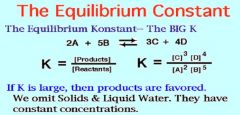![]()
![]()
![]()
Use LEFT and RIGHT arrow keys to navigate between flashcards;
Use UP and DOWN arrow keys to flip the card;
H to show hint;
A reads text to speech;
17 Cards in this Set
- Front
- Back
|
Equilibrium
|
a state in which both the forward and the reverse reactions continue to occur at equal rates so that no net change is observed
|
|
|
K expressions and K constant
|

units are never given with K
|
|
|
importance of K constant
|
- if ratio of products to reactants matches K value, system is at equilibrium. If ratio not equal to K value, system isn't in equilibrium.
|
|
|
meaning of K constant
|
- K>>1: Reaction is product favored. (concentration of products > concentration of reactants)
- K<<1: reaction is reactant-favored. (concentration of reactants > concentration of products) |
|
|
Reaction Quotient Q
|
When system is not at equilibrium, reaction quotient can be calculated the same way as K value.
|
|
|
meanings of Q
|
- Q<K=reactants must be converted to products to reach equilibrium
- Q>K=products must be converted to reactants to reach equilibrium - Q=K, then system is at equilibrium |
|
|
ICE table
|
I=Initial concentrations
C=Change in concentrations as reaction proceeds to equilibrium E=Equilibrium concentration |
|
|
Equilibrium Constant using partial pressures
|
instead of using concentration (M), pressures of gaseous reactants and products can be used to calculate Kp of a reaction.
Value of Kp will be same as value of Kc (c=concentration) only when the # of moles of gaseous reactants is the same as products. |
|
|
Calculations involving Quadratic Equation
|
If 100 x K < concentration of the reactants at equilibrium, then x on bottom of fraction can be omitted.
|
|
|
Effects of raising stoichiometric coefficients
|
If you raise coefficients of a balanced equation by some factor, the new K value is the old K value raised to the power of the multiplication factor.
|
|
|
Effects of raising reversing reactions
|
The equilibrium constants for a reaction and its reverse are the reciprocals of each other
|
|
|
Effects of raising adding reactions
|
When two or more chemical equations are added to produce a net equation, the equilibrium constant for the net reaction is the product of the equilibrium constants for the added equations
|
|
|
Le Chatelier's Principle
|
A change in any of the factors that determine the equilibrium conditions of a system will cause the system to change in such a manner as to reduce or counteract the effect of the change
|
|
|
Ways to disturb equilibrium
|
1. changing the temperature
2. changing concentration of reactant of product 3. changing the volume (for gases only) |
|
|
Temperature's effect on equilibrium
|
- when temperature of system at equilibrium increases, equilibrium will shift in direction that absorbs heat (endothermic direction)
- if temperature decreases, equilibrium will shift in direction that releases heat (exothermic direction) |
|
|
Effect on equilibrium by addition of products or reactants
|
- adding more products to reaction at equilibrium causes the reaction to shift toward reactants because more reactants must be produced to compensate for added products
- if reactants added, more products formed to compensate for added reactants. |
|
|
Volume effect on equilibrium
|
- volume decrease leads to change in equilibrium composition to one having smaller number of molecules
- volume increase leads to change in composition of the side favoring the larger number of molecules - for reactions in which there is no change of the # of molecules, volume change will have no effect. (H2(g) + I2(g) <-> 2HI(g)) |

